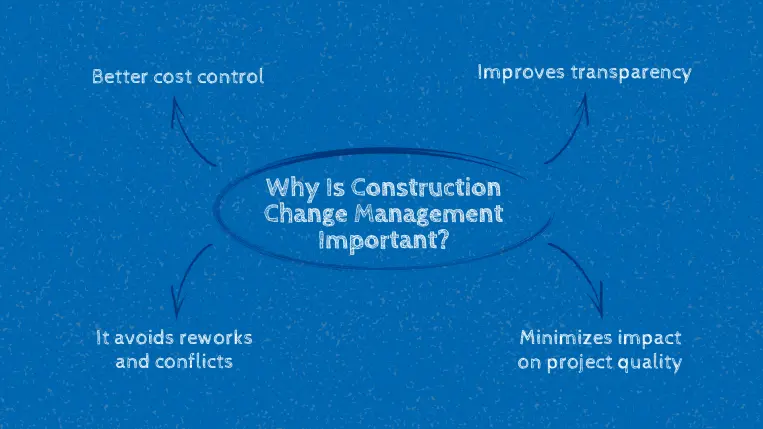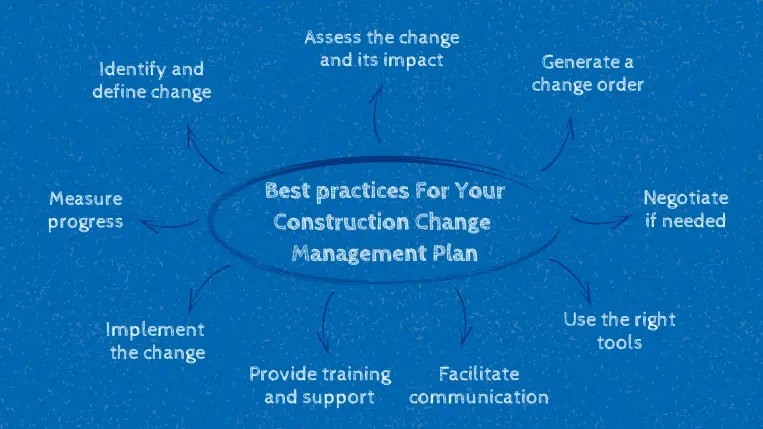11 mins read
A Complete Guide To Successful Construction Change Management

Construction projects involve numerous stages, from preconstruction planning to the final delivery. If there is one thing you can be sure about, some changes will be made along the way. One of the critical areas of construction management is adapting to these variations and implementing organizational change effectively to ensure work is completed successfully within the expected time frame and budget.
70% of organizational change projects fail due to poor implementation and management. A detailed plan for introducing change within your company can help you beat the statistics and remain profitable.
This guide explores the value of effective change management in the construction industry and provides tips and best practices for successfully implementing it. Let’s start with a definition!
What Is Change Management In Construction?
Construction change management refers to the process of preparing and managing project stakeholders to implement changes in a construction project. If not implemented carefully, changes can cost construction companies time and money and affect client satisfaction.
Some examples where change management can be beneficial during a project include:
- Changes to project scope and objectives
- Mitigate the consequences of poor project management in construction
- Inaccurate project specifications
- Errors in architectural design
- Issues with coordination between project stakeholders
- Procurement of low-quality materials and equipment
- Legal and regulatory roadblocks
- Financial issues
- Supply chain issues
- Unexpected site conditions
That said, construction change management does not happen only on a project level. While projects will always involve change during their lifecycle, changes can also occur on a more significant organizational level.
The goal is to adopt new systems, technologies, or standard operating procedures that help improve the current system and drive positive growth. Changes can be small and adaptive (like using new software) or large-scale, involving a substantial organizational shift. Let’s explore some types of change management below.
Types Of Change Management
- Organizational change refers to changes that impact the organization, with communications coming from an executive level. Examples include merging, acquiring another company, or relocating an office.
- Personnel change can happen individually, such as a C-level executive leaving the organization, or on a large scale, such as significant employee layoffs. If not managed correctly, this type of change often generates uncertainty within the organization and can significantly affect construction productivity.
- Remedial change occurs in response to a situation affecting the business. The changes mitigate the consequences and provide support to employees. Examples include mistakes made during project planning and design.
- Unexpected change refers to any disruptive situation that was not planned or accounted for, such as a data breach or a natural disaster. The implemented modifications help prevent the situations from happening again or be better prepared to tackle them.
- Transformational change is the most challenging yet rewarding change an organization can implement. It usually involves changing the company’s operations for better outcomes, such as adopting sustainable construction practices or expanding into a new market.
Why Is Construction Change Management Important?
Organizational change is necessary for construction companies to grow and succeed. How each company manages the changes will significantly define the success of the following activities. Unfortunately, many companies in the industry are still afraid of change due to the high risk it represents. However, change can be good with the support of the right tools. Thanks to the rise of digital construction technologies, construction companies can manage change effectively to make their project outcomes and their organizations as a whole way more productive. Let’s explore some benefits below.

▷ Better cost control
If you work in the construction industry, you know nothing happens without careful planning. The same is true when it comes to change. Efficient change management involves evaluating the change’s impact in terms of time and money, conducting an impact assessment analysis, considering alternative options, and much more to ensure the change is implemented in the most efficient and cost-effective way possible. Doing so helps to efficiently manage the associated costs by carefully allocating resources to avoid unexpected overruns.
▷ Improves transparency
Efficient communication in construction is crucial to completing a project because of the many stages, tasks, processes, and people involved in a building structure. If all these pieces work towards different goals, significant issues will arise that can have significantly dire consequences. This is why an efficient construction change management plan is so important. The process enhances transparency by informing all stakeholders about the changes to ensure they can adapt their workflows accordingly and provide feedback or assistance where needed.
Professional document management and collaboration software help track change requests, approvals, or associated processes to ensure complete transparency and accountability.
▷ Minimizes the impact on project quality
Let’s be honest; you can do nothing to avoid changes in your construction projects. Unexpected change is part of our industry’s nature, but how you manage it is what really matters.
In the worst-case scenario, unexpected changes can lead to costly overruns, issues with subcontractors and the client, and a completely rushed project that does not meet the expected quality standards. In the best case, you had a well-thought-out change management plan that helped you mitigate the impact of these unexpected situations and deliver the project within the original timeline, maintaining quality and good relationships with all stakeholders.
▷ It avoids reworks and conflicts
Expanding on the previous point, poorly managed changes can lead to costly reworks and conflicts with subcontractors and clients due to unexpected costs and work not accounted for in the construction bidding process. By carefully considering the impact of changes on the project design, schedule, and budget, you’ll avoid disputes among stakeholders as everything is clearly communicated and decisions are made collaboratively.
Common Challenges In Construction Change Management
Now that you understand the benefits of change management in construction projects let’s explore its associated challenges. Although 73% of organizations expect the need for change management to increase in 2024, many still struggle due to a lack of resources, efficient planning, or other issues.
Correctly managing construction industry change can be challenging but rewarding. Knowing potential bottlenecks can help one feel more prepared to approach the process.
- Resistance to change is one of the biggest challenges construction companies face during this process. Ignoring that something needs to be changed can only lead to wasted resources, expensive reworks, and unhappy stakeholders. Therefore, being open to change and having a good strategy to manage it correctly is paramount. Involving all stakeholders in the process is an excellent way to tackle the resistance.
- Inadequate planning is another challenge that companies face. While you might intend to make a change, if you don’t understand what that change is about, its impact on the project, and what you need to do to implement it successfully, then the change will do more harm than good. Therefore, you should always conduct a detailed assessment and plan before anything else.
- Pressure for approval is a constant challenge in construction projects. Many times, contractors might realize a change needs to be made while on-site and need to fill out documents and paperwork to get approval from the client. Professional collaboration software, such as RIB Connex, connecting on-site and office teams in real time is an excellent solution for this hassle. This tool provides the perfect collaboration and document-sharing environment to ensure decisions and approvals are made promptly.
- Restructuring the project schedule after implementing the change can become particularly challenging. With all the time spent planning for the unexpected change and waiting for the approval to implement it, it is almost impossible to think the original schedule will not suffer from delays. Good coordination with contractors might help restructure the timeline of the project to ensure delays are minimized.
Best Practices For A Successful Construction Change Management Plan
The change management process in construction is complex, as it requires multiple people and areas to accommodate the changes in the most effective and least cost-impactful way. Some essential steps and best practices must be followed to ensure the process’s success.
Below, we discuss the top construction change management best practices.

1) Identify & define the change
The first step seems obvious, but many overlook it. Before doing anything, you must define the change you want to implement in your construction business. Whether it’s adopting innovative technology or adjusting your standard project processes, this first step is crucial.
Defining the change will enable you to see its value and determine how much time, effort, and resources you should invest in it. The key question to consider is, “Why do we need this change?” Analyzing whether the proposed change aligns with your company goals, objectives, and values is critical in this first step. It should contribute to company growth and assist you in reaching your goals.
2) Assess the change & its impact
Now that you know what you want to achieve with this change, you need to assess its impact at all levels of your organization. To do this, you must consider four factors: time, scope, cost, and risk. Understand how the change will influence your company’s elements and determine the best approach to minimize issues. The change should enhance your construction business and drive vertical growth in these areas.
In addition, you need to consider the impact on your workers, as you can determine the best ways to implement the change and support those who need it. This will ensure more seamless adoption.
Professional construction software, such as RIB Candy, offers seamless planning features that help you link time and money into a single interface to make the most efficient and informed change implementation possible.
3) Use the right tools
Digital transformation is becoming increasingly important and the main driver of change in construction. New systems and software help construction companies automate tedious tasks or enhance the accuracy and efficiency of specific processes. This digitalization enables them to remain competitive by improving all project areas.
As mentioned, changes in construction can be organizational or at a project level. Some project-related ones can be small, and tracking all of them manually from beginning to end can become challenging, as some might slip through the cracks without you even noticing.
This issue is eliminated with the help of professional construction change management software that automatically tracks all changes to ensure they are carried out correctly. Plus, the software allows for deeper analysis of the time and cost impact of the changes to help project managers adapt to the schedule and learn for future projects. Additionally, the right software will keep everyone connected by offering a centralized location for document sharing and collaboration, enhancing transparency, accountability, and productivity.
4) Generate a change order
A change order is a document that details the nature of changes, costs, time, and additional work they will require. It is used as a formal document to modify the original project contract and usually follows change guidelines specified in the contract.
When the need for change is identified, contractors should generate a change order, sign it, and send it to the client for approval. Generating such documents is of utmost importance, as any changes made without approval can put the contractor in a difficult position later.
To avoid wasting time generating a change order for the smallest things, you should develop a template that can be slightly modified depending on the situation.
5) Negotiate if needed
Sometimes, a change might require purchasing additional materials from suppliers or services from subcontractors. If this is the case, you must compare the cost estimates for the change with the price charged and negotiate if there are significant discrepancies. The goal of the negotiation will be to mitigate the cost impact of the change.
6) Facilitate communication
We have often mentioned how communication is a critical factor in change management. Changes can only be adequately adopted if solid communication systems are in place. This should include a clear flow of information from managers to the construction workers. Everyone should be prepared for the new change and have a good understanding of how the new system will work.
7) Provide training and support
A big challenge when implementing change is facing resistance to it. People get comfortable doing things in a certain way. So, when you change things suddenly, it could completely disrupt operations. To avoid this, you must provide the appropriate training and support during this process. That way, you ensure your teams and workers can adapt quickly to the new changes.
8) Implement the change
If you followed all the best practices mentioned here, you would be in an excellent position to implement your change. However, the work does not end there. During the implementation process, you should use real-time reports to track all activities related to the change to ensure everything is going according to plan.
9) Measure Progress
The last step in effective construction project change management is to measure its progress. For example, if you started using new construction project manager software, you can measure its impact on your project efficiency and performance. By measuring progress, you can determine whether the change was effective and achieved what you expected it to.
Measuring the progress and impact of changes from a project perspective is also valuable practice, as it can help you learn from your mistakes and improve in future work.
Conclusion
Organizational change is an inevitable part of construction management. Preparing for the unknown and being ready to take on new changes is essential to any construction manager’s job. Take the right approach, and you will see positive growth within your construction company.
At RIB Software, we provide construction companies worldwide with a professional toolkit to manage all aspects of their projects and digital transformation. Book a demo today to experience the power of innovative construction solutions!
Most Recent
11 mins read
10 mins read
10 mins read
29 mins read
Blog Categories

Ebook











